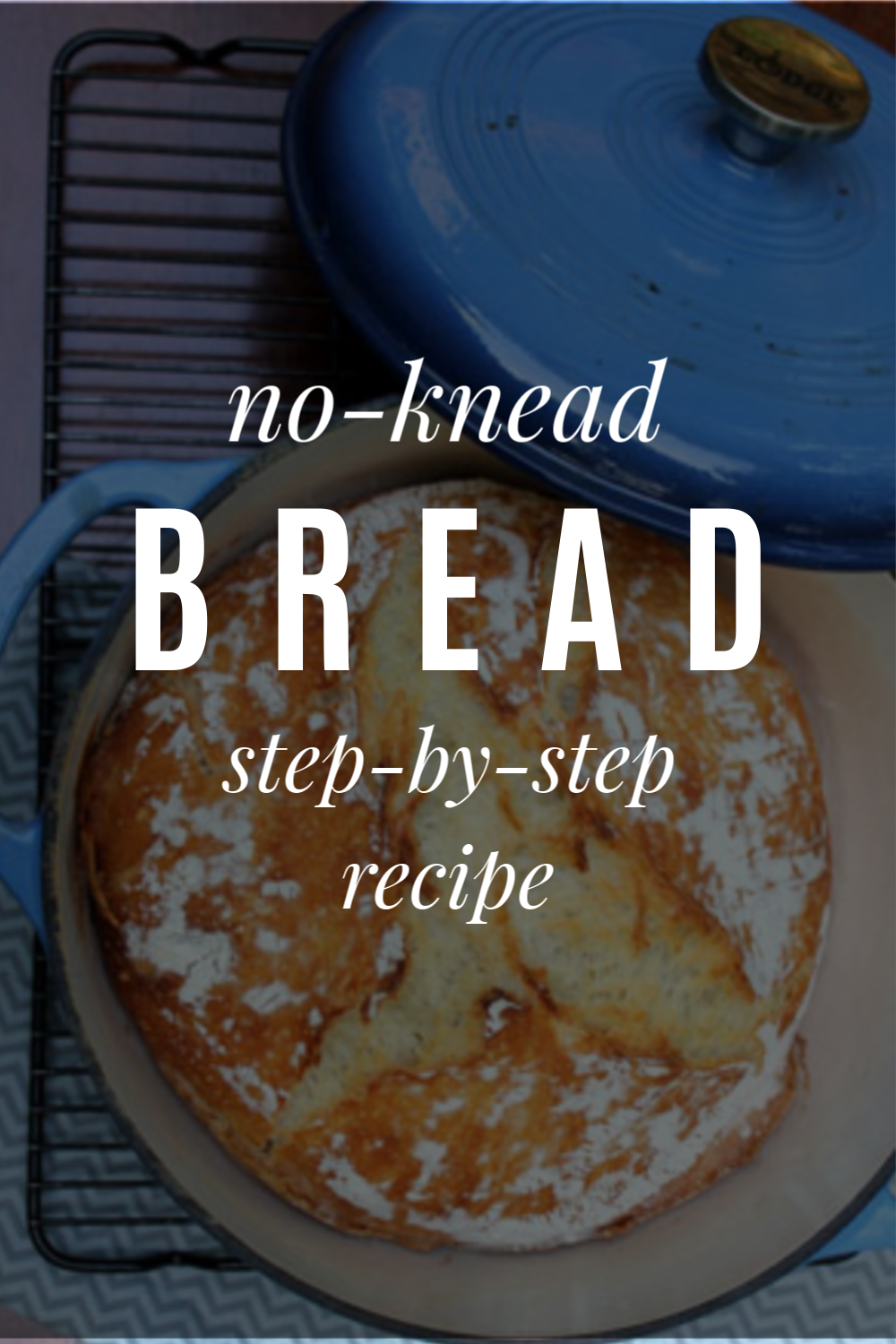
No-Knead Bread Recipe
If you have been hanging out around Frugal Living NW for awhile, you know that I am a big believer in making food from scratch at home. With a few exceptions, I prefer creating something in my own kitchen to buying it in the grocery store.
Bread can be tricky, though. There is some stiff competition out there, and it is tough to replicate a commercial oven’s heat and steam in a normal home kitchen.
For the last several years, I thought that Artisan Bread in 5 Minutes was the best thing since, well, sliced bread. It was simple, and we were content with the results. That is, until last summer when our neighbor brought over a beautiful, delicious loaf of home-baked bread. We had to know her secret. One phone call, and she came back with the book, My Bread by Jim Lahey (Amazon).
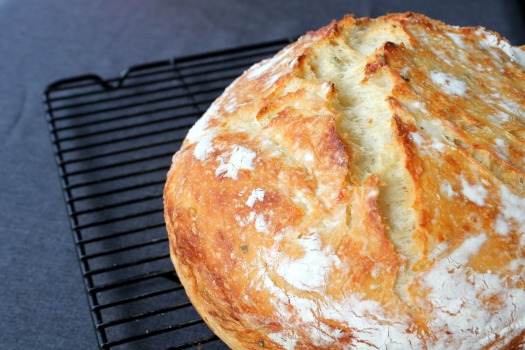
We have been baking bread using this method ever since. I can count on one hand the number of times I have bought bread in the store since then, because I can now make an artisan-quality loaf at home for a fraction of the cost.
I am telling you, this is consistently the best bread I have ever made in my kitchen. Okay, enough gushing. Let’s make some bread.
The only changes I have made to Lahey’s method is to double the amounts and adjust the baking time and temperature to achieve a bigger loaf with a thinner crust.
Oh, and don’t be put off by all these steps. This is totally possible for home bakers at any skill level. I wanted to give you the confidence to do this on your own. A concise recipe can be found at the bottom of this post.
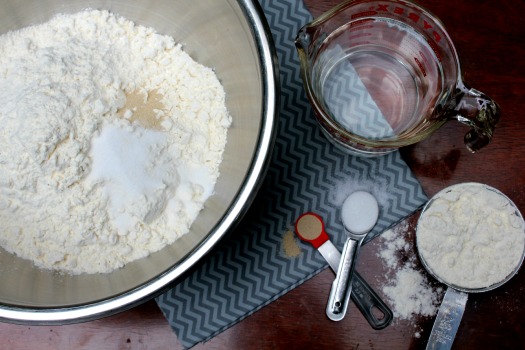
The ingredients are simple: flour, water, salt, and yeast. My husband calculated this bread costs 74¢ per loaf (using Bob’s Red Mill flour & Costco yeast).
Oh, wait! Don’t forget to factor in the roughly 8 cents of energy used to bake it for an hour. No, I’m serious. My husband really does think about this stuff! He’s funny.
So, there you go. A whopping 81¢ for a substantial 2.5 pound loaf of bread. That is crazy cheap.
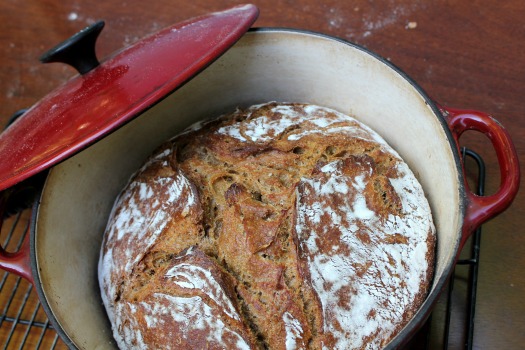
If you want to use some whole wheat flour, substitute 3 cups of whole wheat for 3 cups of the all-purpose flour (3 cups whole wheat and 3 cups of unbleached flour for a total of 6 cups) and add 3 Tablespoons of molasses (optional). This will produce a slightly sweeter, denser loaf of bread. Delicious.
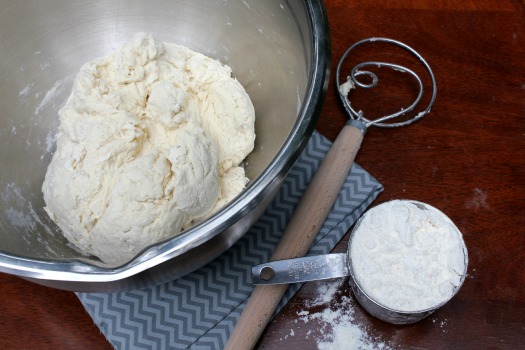
Combine the dry ingredients, add the water, and stir to combine (the funky looking wood-handled item is the amazing Danish Dough Wisk — makes stirring stiff dough a snap). The dough should be wet and sticky. Depending on the temperature and humidity in your home, you may need to add a little more flour or water, 1 Tablespoon at a time. So far, these steps are exactly the same as the 5 Minute method.
The main differences are that you use significantly less yeast (1/2 teaspoon vs. 1 1/2 Tablespoons) and significantly more initial rise time (12-18 hours vs. 2 hours).
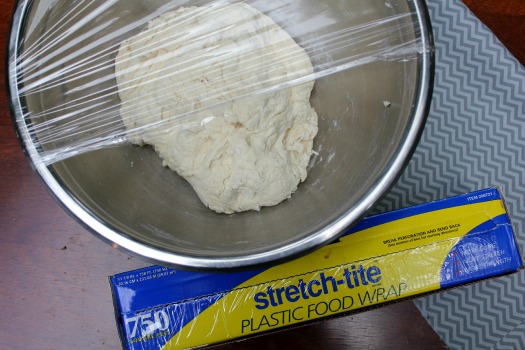
Once the ingredients are completely combined, cover the bowl with plastic wrap and leave it on the counter to rise for 12-18 hours. This slow rise aids in the fermentation of the yeast, giving the bread a better flavor.
Okay, I know what some of you are thinking: 12-18 hours! That’s ridiculous! Who has that kind of time?! I get it.
However, here are two things to consider:
- Once you get into a rhythm of baking your own bread, it’s not a big deal. I start mine in the afternoon or evening and bake it the next morning or afternoon. This would also be an easy weekend routine.
- Just like the title claims, this bread requires no kneading. It is not fussy, temperamental dough. You can produce a delicious loaf of bread with very little hands-on effort & experience.
You’ll know your dough is ready when it has risen in the bowl, smells yeasty, darkened slightly, and is covered with small bubbles.
Using well floured hands, shape and tuck the sticky dough into a rough ball. You can also fold it over a couple times on a well-floured surface. It doesn’t have to be perfect; just keep quickly tucking the dough underneath with your fingertips until you have a semi-smooth dough ball. The dough should be wet but manageable; you don’t want a wet blob so sticky that you can’t shape it into a ball.
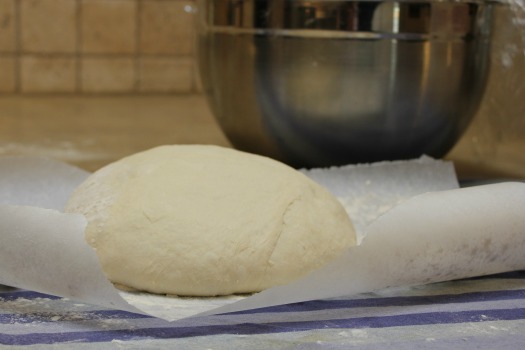
Take a clean linen or cotton tea towel (not terry cloth) and dust it with flour, cornmeal, or wheat germ to prevent the dough from sticking to the towel as it rises. You can also use a floured square of parchment paper on the towel to make the dough ball easier to handle. Place the dough ball, seam side down, in the middle and dust with more flour.
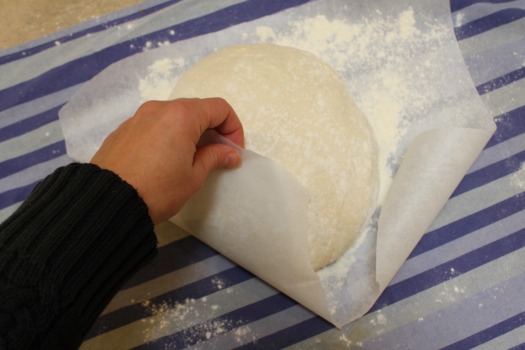
Cover the dough with the (parchment paper and) towel and let it rise for 1-2 hours at room temperature, until doubled in size. During the last 30 minutes of rise time, place a heavy lidded 6-8 quart pot, like a Dutch oven, in a cold oven and preheat it to 425 degrees.
Confession: I own three Dutch Ovens. I use them all the time. They are incredibly versatile and worth the investment. If you don’t own one, you could also make this in any lidded pot, provided it is oven-safe at such high temperatures. Also, check the knob on your pot. If it isn’t rated for such high heat, you’ll want to remove it or cover it with foil. You can also buy an inexpensive replacement knob that is rated for higher temps!
Okay, this is the trickiest part of the entire operation. Remove the lid from the piping hot Dutch Oven, slide your hand underneath the towel or parchment paper, and flip the risen dough (seam side up now) into the pot. Try to flip close to the pot or the flour will fly everywhere. Remove the towel or paper and set aside.
This might take a bit of practice, but again it doesn’t have to be perfect. Some of my worst flips have produced my most beautiful loaves. I love what Lahey writes, “…even the loaves that aren’t what you’d regard as perfect are way better than fine.”
Place the lid back on top and slide the pot back into the hot oven.
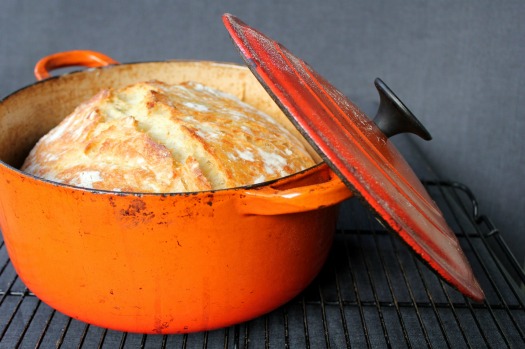
Bake it for 40-50 minutes. Remove the lid. Bake for another 5-10 minutes, until golden chestnut brown. The internal temperature should be around 200 degrees. You can check this with a meat thermometer if you’re nervous about knowing when your loaf is done.
Oh man, your house will smell so good about right now.
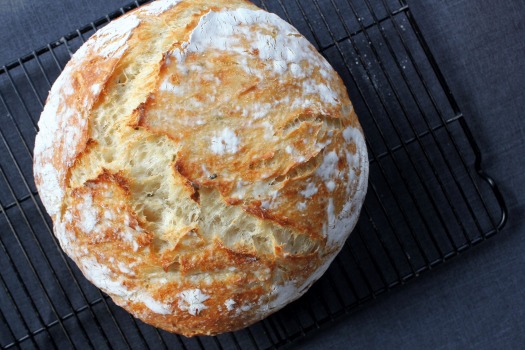
Place the loaf on a cooling rack. You will hear it crackling as it cools. Use every ounce of self-control to resist cutting into it until it is “quiet”; cutting it too soon will make the bread dense and gummy.
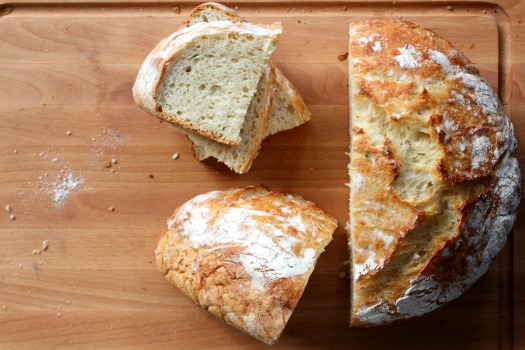
This bread is best the first 2-3 days. I just store my leftover loaf inside the Dutch oven on the countertop. Using plastic wrap will soften the crust. Dry, leftover bread makes great bread crumbs, toast, French toast, or croutons!
Enjoy. And pat yourself on the back. You just baked an amazing loaf of bread!
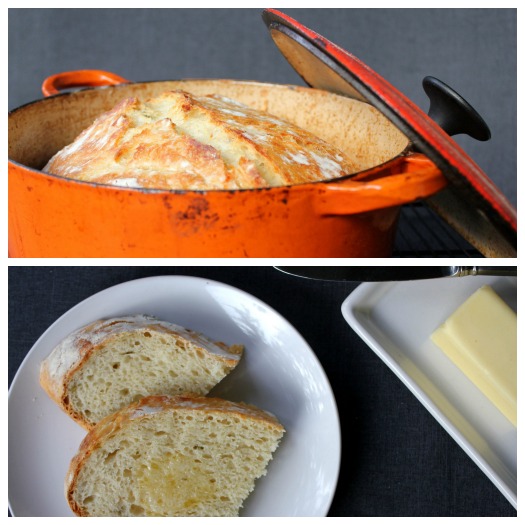
Basic No-Knead Bread
Slightly adapted from Jim Lahey’s My Bread
Ingredients
6 cups bread flour (recommended) or all-purpose flour, plus more for work surface
1/2 t. instant or active-dry yeast
2 1/2 t. salt
2 2/3 c. cool water
- In a large bowl, combine the flour, yeast, and salt. Add the water and stir until all the ingredients are well incorporated; the dough should be wet and sticky. Cover the bowl with plastic wrap. Let the dough rest 12-18 hours on the counter at room temperature. When surface of the risen dough has darkened slightly, smells yeasty, and is dotted with bubbles, it is ready.
- Lightly flour your hands and a work surface. Place dough on work surface and sprinkle with more flour. Fold the dough over on itself once or twice and, using floured fingers, tuck the dough underneath to form a rough ball.
- Place a full sheet/large rectangle of parchment paper on a cotton towel and dust it with enough flour, cornmeal, or wheat bran to prevent the dough from sticking to the parchment paper as it rises; place dough seam side down on the parchment paper and dust with more flour, cornmeal, or wheat bran. Pull the corners of parchment paper around the loaf, wrapping it completely. Do the same with the towel. Let rise for about 2 hours, until it has doubled in size.
- After about 1 1/2 hours, preheat oven to 425 degrees. Place a 6-8 quart heavy covered pot, such as a cast-iron Dutch oven, in the oven as it heats. When the dough has fully risen, carefully remove pot from oven. Unwrap the towel and parchment paper from around the dough and slide your hand under the bottom of the dough ball; flip the dough over into pot, seam side up. Pull the parchment paper off, scraping any stuck dough into the pan. Shake pan once or twice if dough looks unevenly distributed; it will straighten out as it bakes.
- Cover and bake for 40 minutes. Uncover and continue baking for 10-15 more minutes, until the crust is a deep chestnut brown. The internal temperature of the bread should be around 200 degrees. You can check this with a meat thermometer, if desired.
- Remove the bread from the pot and let it cool completely on a wire rack before slicing.
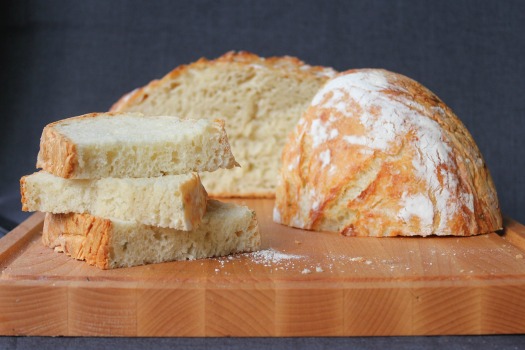
Here are a couple options for Dutch Ovens. Any heavy, lidded 5-8 quart pot (seasoned cast iron or enamel coated) would work with this recipe. Lodge has the best prices/options for dutch ovens on Amazon.
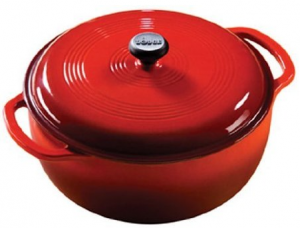
Lodge Logic Dutch Oven in Island Spice Red (6 Quart)
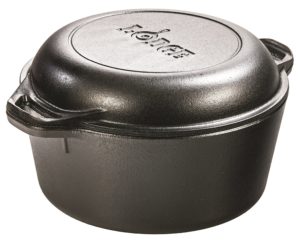
Lodge Cast Iron Double Dutch Oven (5 Quart)
If you already have a dutch oven (or find a deal on a lesser-known brand) that doesn’t have a knob rated for high temps, replace it! There are some really affordable options.
Got questions? You are in good company. Go here for the complete FAQ list.
Looking for more variations to the no-knead bread recipe? We’ve created a list with sweet and savory varieties, including the following:
- Cranberry Orange
- Four Cheese
- Sandwich Bread
- Dark Chocolate Coconut
- Tomato Basil Cheese
- Whole Wheat
Looking for more delicious bread recipes?
Find more delicious recipes on our Recipe Page!
Follow Frugal Living NW on Pinterest!
Fantastic range of boards from best recipes and tips for frugal living to gardening and budgeting help.
This post may contain affiliate links. See the disclosure policy for more information.
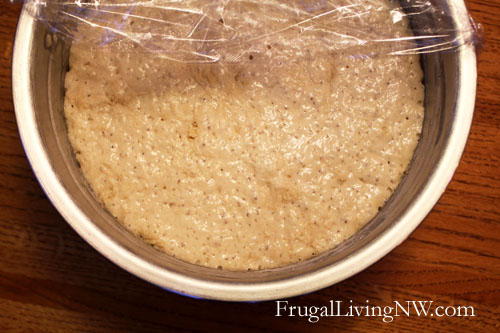
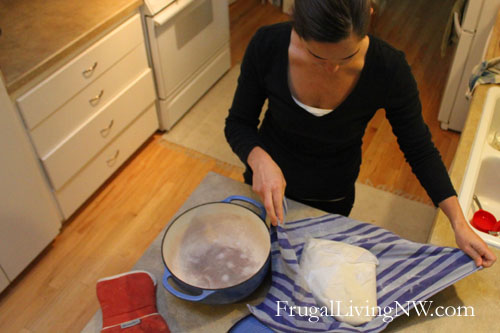
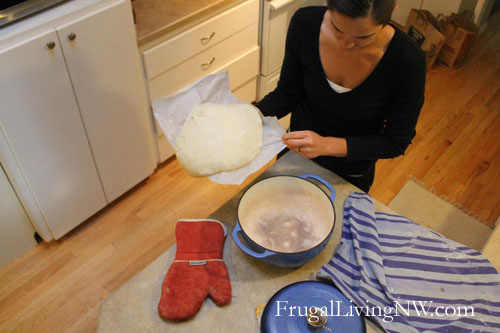

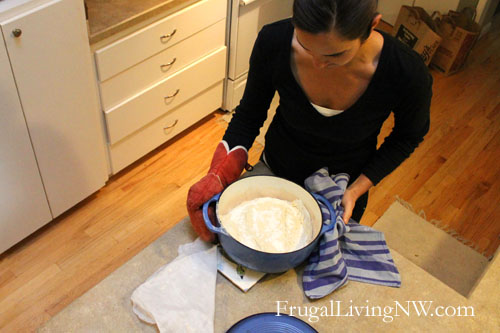
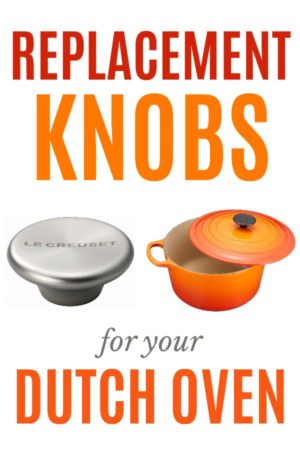

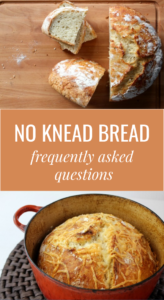
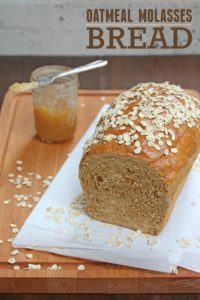
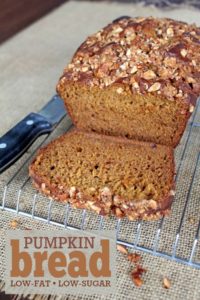
Thanks so much for the recipe! It was my first time ever making bread! All was great except it came out super salty. I used tablespoons I stress.. Oops!
THANK YOU for this great recipe. I’ve made 2 loaves and still have a problem with it being ‘doughy’ in the center. I checked to make sure it was 200 degrees, using a thermometer and still confused. It looks beautiful and the crust is amazing….just too darned doughy. The first time I used the exact amout of water. The second time I added an extra 2/3 Cup. Am I doing something wrong that you might know of? Thanks for any help!
Huh, I can’t imagine what’s happening unless your oven temp or thermometer isn’t accurate. Are you following the baking times and temps exactly as written?
Yep…followed everything to the “T”. When I went back to read the blog after the 1st one was done I noticed folks were adding more water. So I added 2/3 more on the 2nd loaf. I’m wondering if I should bake it longer…..Gotta make this work! Too easy to fail me now! It’s a BEAUTIFUL loaf so I HAVE to perfect this!
This was so easy to make and delicious! I’ll be making it every week from now on. Thanks for posting it!!
My first try is in the oven right now. It stuck horribly to my heavily floured towel! Any ideas on what went wrong? I did have to add a bit more water – but I added a little at a time.
Baked this today. I used 3C white & 3C wheat flour and following the rest of the directions including adding the molasses. The loaf is huge! Crisp and crunchy on the outside and moist & chewy on the inside. I will certainly make this again. The only thing I will do differently is to NOT use black strap molasses. It gives a slight burnt/bitter taste. Next time regular molasses. I might also try baking just 1/2 the recipe in a smaller dutch oven.
Overall – 2 thumbs up!
THANKS for a great recipe.
OMG!! I just made this… it is AWESOME! So very easy.. the hardest part was waiting for it to cool enough to cut! We are big bread people & very picky.. this tops the list!
I’m making this bread for the first time. I decided to experiment with the base recipe…I added in some sharp cheddar cheese, fresh roasted garlic, and Italian seasonings. If it doesn’t go as planned, I’m out a whoppin $2.00 ?!?!
That sounds like a delicious combination!
How did your bread turn out? I’ve been wanting to experiment with some herbs & cheeses.
Just wanted to say THANK YOU for this awesome recipe! I’ve tried another one before, but it didn’t work out for me – much too wet of a dough. This was perfect on the first try, AND I used a large stainless steel stock pot with no issues (was at my mom’s, and she doesn’t have a dutch oven). I’m planning to make a bunch of half-sized loaves for an upcoming bake sale since this is so painless – might even experiment w/ some mix-ins…
Yay! Glad to hear it. And thanks for the comment about the stock pot. Good to know!
Is it okay to use a 4 Qt. iron dutch oven. Just got a new one for the recipe but didn’t know I needed 6 to 8 qt. size. I can hardly wait to get started.
I’m not 100% positive. Might be too small? You could always try half a recipe first and see what you think. Cut amounts in half, follow the directions as written, and bake at 425 for 30 min. covered 10-20 uncovered (until internal temp of 200 and golden brown crust).
I just finished baking this. The loaf is currently crackling on the counter and the house smells amazing. Can’t wait to taste it.
Loved it! Made it on Monday and have used it for sandwiches, garlic bread, and ate it with simply with butter & honey. I’m ready to start another one. Is it absolutely necessary to add molassas with the wheat flour? Just wondering what would happen if I tried it without.
Nevermind. I do have molassas. Can’t wait to try the wheat.
Great! It would be fine to omit the molasses, if you prefer! Molasses & whole wheat are nice partners, and I like the touch of sweetness with wheat bread. Up to you!
Great easy recipe. I have been using for about four years. Try adding 1/4 cup of anise seed and 1 Tbsp coarse ground pepper for a great tasting bread for pasta dinner.
I can’t wait to try this!!! Thank you for sharing! Also, for those of you who have a Dutch oven that does not have a handle that can withstand high heat…here’s a tip; My husband got me a Lodge Dutch oven that was well priced, then bought a Le Crueset knob on ebay and replaced it so that it could withstand higher temperatures. I just thought that was really smart, and much cheaper than going with the more expensive Dutch oven.
Beautifully documented, I’ve been using Lahey’s recipe for years…respectfully if I may your bread looks perfect except for the crumb which looks a little tight. The original recipe is one of high hydration ( at least 75% by weight) and it looks like you’ve cut back on the quantity of water perhaps to make handling easier? In Jim’s original video for the NY Times he’s barely able to fold the dough over a couple of times it’s so wet and this as well as very high oven temp (500 deg +) is the key to getting good oven spring, an open crumb and it not sticking. Best wishes.
Nope, I didn’t change the hydration. I doubled the entire recipe, including the amount of water from Lahey’s book, My Bread. In that, he uses 1 1/3 cups of water. I just checked out his NY Times recipe (which ran in ’06) and that lists 1 5/8 cup of water. Interesting! And I plan to post some better, updated pics of the crumb soon; these do make it hard to tell what it really looks like. Thanks for the comment!
Just made this receipe and it turned out picture perfect! I did not however, read the comment about resisting cutting into it before it had cooled (oops) and was a little disappointed. My crust was very thick and hard. I am using my oven on convection. Should I do less time or temp? This was my trial run before making it for my family for thanksgiving (Canada) this weekend so hoping next time it’s perfect. Anyone else have a problem with a very hard, thick crust?
That crust is typical of this type of artisan bread. If it’s not to your liking, you might want to try a recipe for a softer (still using yeast) dinner roll? It sounds like you’re doing it right; hope that helps!
I tried this with a mix of white and wheat flour. I had to add in more flour. I let it rise for 16 hours and everything went ok until it was time to take it out of the cast iron pot and it did not budge. I baked for 40 minutes then I removed the cover and did it for 5 more. Not sure what happened. At the top it looks so pretty and perfect imagine how my heart sank when it did not slide right out.
That aside, I’m willing to try it again this weekend.
In the dozens of times I have made this recipe, I have had it stick in the pot three times. Two times I added too much water and one time I did not preheat the pot for long enough. I know how frustrating that is. If you run a rubber spatula around the outside and shake the pan, it eventually pops out. But trust me, that is not normal.
For your first time, I would recommend sticking to the recipe as written and see how it goes. If you are still having the problem, let me know and I’ll do some troubleshooting.
Am I reading this correctly? You need to put the bread in the pot WITH the towel, place it in the oven, then preheat the oven. After it is hot then you take the towel out from underneath and put it seem side up in the pot? Also is it ok I’m using a no stick dutch oven not a cast iron?
Sorry all the Q’s I’m new to baking.
Bethany, you will put the pot in the oven empty so it can heat up at the same time you are heating up the oven. You want the pot to be hot when you put the dough in it. She then says to slide your hand under the towel( with the dough still on the towel) and flip the dough into the hot pot. I hope I expained it well enough.
I made this recipe and it turned out great, but with a few changes (sorry!) because I only have 100% whole wheat flour, and no AP flour in my house. I chose to add gluten for the stretchiness and so it can rise properly.
I halved the recipe because my dutch oven is much smaller (4 qts, I think). I used 3 cups whole wheat flour and added 1 teaspoon of vital wheat gluten per cup of flour. I had to use considerably more water (probably 1/2 cup more than half of the recipe) probably because of the added gluten and the wheat flour. I also used active dry yeast, and choose to proof it first, because I wasn’t sure it would work without doing this, and I couldn’t tell from the recip eif I should.
With those changes, the bread rose perfectly and is delicious! This was so easy, thank you!
My hub made this yesterday after I found the recipe here and printed it off. Once he had mixed it and left it until the next day, I tucked under the dough, floured the towel, etc. I have to say I am very impressed how easy it all was and how beautifully the loaf turned out. My mouth is watering and I want to taste-test it, but we are waiting to cut right before family arrives for dinner tonight.
Oh yeah, he added another cup of water to the recipe. I thought it might be too wet, but it turned out great – large and puffy, just like the picture. We used 1/2 whole wheat, but not actual “bread” flour.
Thanks so much for sharing the recipe!
Can I double this recipe & still bake it all together? I am cooking for a group this weekend & would love to make more that the one loaf.
Thanks!!
Leslie, I just made this and the loaf comes out *huge*. You could only double this if you used two dutch ovens, one for each recipe. I would mix each recipe separately if i was making two.
This recipe does make one huge loaf! I served this bread at a big party and baked two loaves, one with some whole wheat and one all white. Just double the recipe and keep the loaves separate through all the steps. You should be able to fit 2 Dutch ovens in your oven at the same time. If you don’t own 2, then bake one and give the second a longer initial rise time (just time it to work with the first loaf).
I just baked, cooled and tasted this bread and it’s awesome! It’s going into my recipe book for sure.
Sorry, but I have another question. Can you make rolls with this recipe? Again, Thanks……….Linda
Can the dough be frozen? Thank you.
I just want to make sure I’m reading it correctly– if using whole wheat flour, use only 3C of whole wheat flour and 3tbsp of molasses in lieu of the 6C of reg flour, yes?
No, you would substitute 3 cups of whole wheat for 3 cups of unbleached. So you still are using 6 cups of flour total. Hope that helps!
Let me just preface this comment with my bread-baking skills: They’re nonexistent. I’ve ruined everything from breadsticks to cinnamon rolls before… no matter how easy they seemed. This is the FIRST bread recipe I’ve ever tried that’s ever actually baked looking anywhere near the recipe. It turned out beautifully. Thank you so much for sharing! 🙂
Thank you so much for this recipe which I tried for the first time today. The texture is similar to ciabatta, which is just what I wanted. The method was really easy – I didn’t seem to have any of the problems with dryness or sticking to the towel that others have had. I halved the recipe – maybe I didn’t cook it enough as it was not as crispy as I expected. I’m looking forward to experimenting with this as a base recipe for other varieties. Cheers from New Zealand!
This is great, thanks! I was wondering if you (or anyone) has tried with 100% whole wheat flour – maybe I should add vital wheat gluten?
Thank you so much for this amazing recipe, my whole family loves it! Easy and gorgeous!
I had to add more water too–To the white flour.
The Rice four recipe didn’t work, no rise at all after 15 hrs.???
Not sure why, afraid to try the oat flour becasue the rice didn’t work.
I cannot have gluten so I guess I need to find another bread recipe for these flours???
Costco, Sam’s Walmart have gluten free flour that I have used in other bread recipes for my granddaughter.
Just came across this recipe and I dont know if it will work but u can also try coconut flour or tapioca flour…both r glueten free. I use those bc I cant have eggs, wheat, or soy..hope it works
I’d be interested to see if this works… Please update if you do make it… Thanks
I was so exited to make this bread, but the 2 2/3 c water was not enough to make a moist dough with the 6 c of flour, I added 2/3 c more water, will see if it rises, help ?
I agree. I have made similar breads in the past but decided to try your recipe. The 6 cups of flour with 2 2/3 cups water was not enough so I also added an additional 2/3 cup water. Hope it works. Any pointers???
Update: my bread turned out awesome by adding the 2 2/3 cups of water!!
Oops…I meant 2/3 cups water extra
Thank you so much! Made this overnight and baked today. It looks absolutely wonderful!!!
Is there a high altitude variant that you are aware of?
I am at
6000 ft. No problems
Thank you kindly!
No problem, enjoy!
How will this work with fresh ground whole-wheat flour?
I have made it with no problems using whole wheat bread flour.
Can it be made with oat four or rice flour?, I use gluten free foods
I doubt that it would work with non-gluten flour. Gluten is what makes the dough stretchy so the yeast can make the bread rise with lost of tiny air pockets.
I was just wondering, do you make or have a whole wheat version of this recipe? That would make me a VERY happy camper! If not I guess I could try it with whole wheat pastry flour?
Is it necessary to coat the Dutch oven with something to keep it from sticking to the pan?
thanks for sharing this interesting recipe and great pictures and details!
Thanks for your fine post on a wonderful product!…
I grind my own wheat and with adding molasses, can you taste it?
For those having trouble with the bottom being to dark. Try putting something between the pot and heat. You may have put your rack down to accommodate the taller pot, placing the bottom of the pot close to the heat.
Hello! I tried your recipe yesterday, and it turned out pretty well! I used half of the amount because my dutch oven is smaller. However, the bread wasn’t very fluffy nor full of holes. I used white whole wheat flour. What would you recommend for getting the nice, airy bread as shown in your pictures?
Whole wheat flour will give you a more dense loaf of bread. Use unbleached white (bread is recommended) flour for a lighter, chewier loaf. You won’t necessarily get a “fluffy” interior with this recipe.
Made my 8 th loaf today! Wanted to try a different bread recipe on pinterest, but decided to just add those ingredients to this one. 2 T tomato paste, 1/4 c parmesan cheese, up to 1/3 cup basil. Yum! Turned out great and the grilled cheese sandwiches were to die for. Going to try the spinach artichoke grilled cheese tomorrow. Thank you for this great recipe. We all have our favorite varieties!
Lynn, those variations sound so delicious. Thanks for feedback!
Tried this recipe out two days ago, and I was pretty happy with how it turned out for a first attempt! (Especially because it was my first time ever making bread.)
Just wondered if anyone had tried halving the recipe?? If so, how did it turn out, and what modifications on rising times and baking are recommended??
Yes, Lahey’s original recipe is half this amount. I doubled it to achieve more bread-to-crust ratio.
Cut ingredients in half; follow directions as written. Bake at 425 for 30 minutes, remove lid and bake for another 15-30 minutes (until internal temp is 200 and it’s golden brown).
I just made this tonight and I have to say…..I CAN’T BELIEVE IT IS HOMEMADE…..It is the best bread I have ever made. Thanks for the great recipe!!
Do you have to let it rise in a metal bowl?
Well i’m a little disapointed with my bread… The bottom was way to hard and i never heard any crackling noises as it cooled.. Any words of advise. Must be 2 Rebecca’s on this site. I did let it raise the 18 hours that it called for?????
Just finished my first attempt and mine came out the same way Rebecca. Wish someone would post advise. The inside was so good but the outside, especially the bottom is just too hard!!
Deborah…. I agree with you….It would be nice to know what to do about this problem…..My bread also had a big hole all the way thru it just below the top crust. I have made a lot of bread in my life and thats why i was so excited to try this one…..
Thanks for the comments, Rebecca and Deborah! This type of artisan bread will have holes in the interior and a thicker, chewier crust. (If you check out Lahey’s book, his crusts are dark and almost charred looking.) To “fix” this problem would take away what makes this bread unique.
That being said, as long as the interior temp is at 200 and the crust is a nice golden brown, pull it out of the oven. Try decreasing your baking time a bit? I also wonder if a sheet of foil under the pot would give you a lighter bottom crust? I’ll try that with my next loaf and let you know.
If that still doesn’t meet your expectations, try a different recipe, like this one for hamburger buns (make in any shape you want) that will give you a thin crust and soft, light interior: http://www.frugallivingnw.com/frugal-homemaking/making-homemade-hamburger-buns-basic-yeast-dough-recipe/
Thank You for your help…. I will try making it again this week